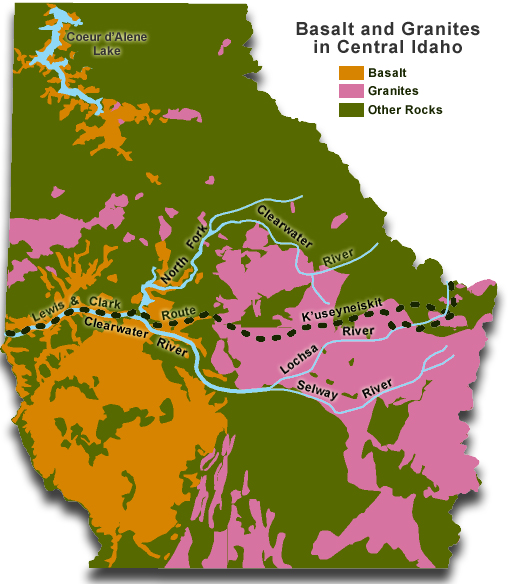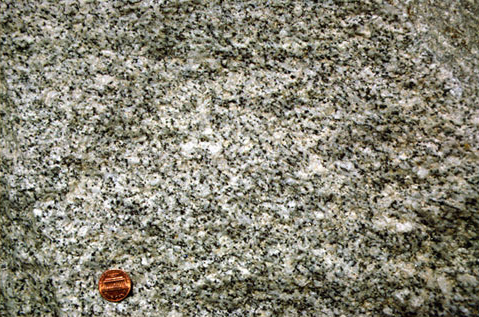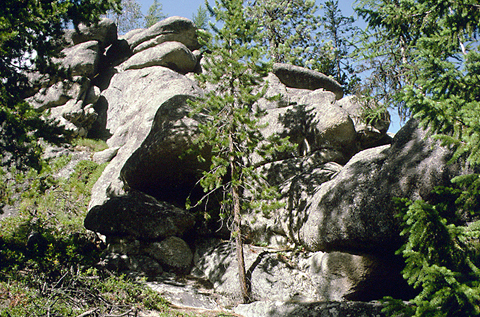We assended a steep high rockey part
of the Mountain high rocks and high pricipicies
The whole geological story of the Bitterroot Mountains is very long and complicated—and somewhat speculative—but we’ll keep it short and stick to the simple facts.
Bedrock in the Bitterroot Mountains is mostly granite. If Lewis and Clark ever cracked a chunk to expose a fresh surface, they saw a very pale rock glittering in the sunlight that reflected off a crystal surface. If they cracked a great many chunks, they would eventually have noticed that most of the granite is very pale gray. Almost white, in fact, and composed of crystals generally smaller than a pencil eraser. That rock has a faintly streaky look, like the grain in a piece of wood. The rest of the granite is composed mostly of crystals larger than a pencil eraser, and not even faintly streaky. Those granites are also pale, but generally pink, or at least pinkish.
Gray Granite
The story of the gray granite begins about 200 million years ago, when the western edge of North America first squashed against the floor of the Pacific Ocean as the continent began to move west. The crumpling continental margin rose into a range of monster mountains that may well have reach elevations of about 20,000-feet. That estimate rests fairly firmly on quite a variety of independent lines of evidence too detailed to consider in this brief discussion.
Heat rising from the depths accumulated in those early mountains until the rocks ten miles or more deep within them began to melt into granite magma—a pasty molten rock. Enormous volumes of that magma, thousands of cubic miles, had accumulated by sometime before 80 million years ago. That excessively high mountain range became so engorged with molten granite, and lost so much mechanical strength that it collapsed. Enormous slabs tens of thousands of square miles in extent, and as much as ten miles thick, sheared off the top of the range and slide east into western Montana on a slippery banana peel of molten granite magma. Some of them moved at least 90 miles. Enormous volumes of the lubricating granite magma erupted from the leading edges of the moving slabs to make volcanoes in western Montana. They produced much of the maze of mountains and broad valleys that the expedition threaded on its way through western Montana and the eastern edge of central Idaho. Most of the magma, however, remained behind in Idaho, where it crystallized into granite when its heavy cover slid off. That is the pale gray granite that is at the surface in most of the country between Boise and Missoula.
The earth’s crust of western Montana sank under the weight of the displaced slabs, so the heights of the mountains are only a fraction of the thickness of the displaced slabs. Meanwhile, the earth’s crust of central and northern Idaho rose after it was relieved of all that weight. That raised the Bitterroot Mountains and exposed the pale gray granite. The erosion surface that began to develop when the gray granite was exposed has since become the dramatic landscapes of the Bitterroot Mountains—with some help from further geological events.
Those events happened between about 890 and 70 million years ago, during late Cretaceous time. Dinosaurs still walked the earth, but vanished at the end of Cretaceous time, 65 million years ago, when Tertiary time began. That brings us to the murky story of the pink granite.
Pink Granite
The mountain ranges of central Montana appeared about 50 million years ago, fairly early in Tertiary time. Some of them owe their existence to large movements of the earth’s crust, others to large intrusions of molten magma at depths of no more than a few thousand feet, still others to volcanic eruptions. No coherent or widely accepted explanation for their existence has emerged from years of debate.
Meanwhile, large masses of molten granite magma rose through the earth’s crust along a broad trend from the vicinity of Boise to that of Helena. That also remains unexplained. Much of that magma erupted, exploded in great clouds of steam loaded with volcanic ash. They spread generous blankets of pale rhyolite (RYE-o-lite) ash across wide expanses of the region. Other enormous volumes of molten granite crystallized at shallow depth of a few thousand feet to make large masses of pink granites. The expedition camped amid very picturesque boulders of pink granite at Lolo Hot Springs, and crossed large masses of it on their way across Idaho.
Both varieties of granite, as well as pale rhyolite ash—a volcanic rock similar to granite—weather into sandy soils, which typically are short of the essential fertilizing nutrients, especially potassium, iron, calcium, magnesium, and phosphate. Even if those minerals are present, rain rinses them out of the soil in regions with a climate as wet as that of the Bitterroot Mountains. Most of the soils in the Bitterroot Mountains are fertile enough to support dense forests, but not enough so to support many edible and nutritious plants. Neither game animals nor people can find much to eat there. Those grudging soils explain why the Corps of Discovery nearly starved in the Bitterroot Mountains. It is a matter of bedrock and climate.
Transition to Basalt
” . . . Rocks, which appear above the timber like Towers.”
—Private Joseph Whitehouse, 13 September 1805
As the Corps of Discovery reached a high point on K’useyneiskit, The Road to the Buffalo, near the western edge of the Bitterroot Mountains on 19 September 1805 they saw a welcome sight—”a level part of the country about 40 miles ahead.” Sergeant Gass dramatically recorded the men’s elation: “When this discovery was made there was as much joy and rejoicing among the corps, as happens among passengers at sea, who have experienced a dangerous and protracted voyage, when they first discover land on the long looked for coast.” Actually, they were only looking at the broad, rich Nez Perce and Camas Prairies south of the Clearwater Canyon, which stand more than 3,000 feet above the camp they would occupy on the Clearwater River near today’s Kamiah, Idaho. Still, they saw flat land, and that was encouragement enough for them.
On the very next day, though, the farmers in the party began to notice changes closer at hand. As Lewis reached the vicinity of Hungry Creek, observed, “the soil as you leave the hights of the mountains becomes gradually more fertile. the land through which we passed this evening is of an excellent quality tho very broken. it is a dark grey soil.” It was essentially the same stuff of which those distant prairies were made—rhyolite mixed with basalt.
The experience of the Corps of Discovery in its crossings of Northern Idaho presaged much of the future development of the region. The geologic past and bedrock still play as large a role in shaping the lives of the people who live there now as they did 200 years ago.
Experience the Lewis and Clark Trail
The Lewis and Clark Trail Experience—our sister site at lewisandclark.travel—connects the world to people and places on the Lewis and Clark Trail.
Discover More
- The Lewis and Clark Expedition: Day by Day by Gary E. Moulton (University of Nebraska Press, 2018). The story in prose, 14 May 1804–23 September 1806.
- The Lewis and Clark Journals: An American Epic of Discovery (abridged) by Gary E. Moulton (University of Nebraska Press, 2003). Selected journal excerpts, 14 May 1804–23 September 1806.
- The Lewis and Clark Journals. by Gary E. Moulton (University of Nebraska Press, 1983–2001). The complete story in 13 volumes.





